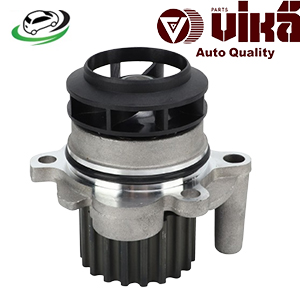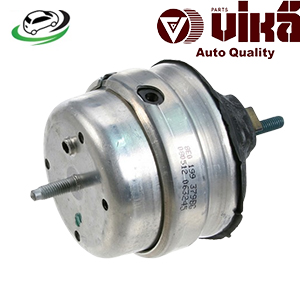-4%
Get Audi B6 A4 FWD 1.8T / Audi B6 A4 Quattro 1.8T / Audi B7 A4 Quattro 2.0T Left Hydraulic Engine Mount 8E0199379BG
In automotive design, engine mounts are critical components that connect the engine and transmission to the car’s chassis. They serve multiple purposes: supporting the weight of the engine, isolating vibrations from the engine to improve ride comfort, and ensuring the engine remains securely in place during operation. Engine mounts typically come in different forms—solid rubber, hydraulic, or electronic—and are strategically placed to handle various stresses within the vehicle.
Among these, the hydraulic engine mount, which is a combination of rubber and hydraulic fluid, has become increasingly popular in modern vehicles due to its ability to effectively dampen both high- and low-frequency vibrations. The left hydraulic engine mount, located on the left side of the engine bay, plays a vital role in maintaining smooth vehicle operation.
2. What is a Left Hydraulic Engine Mount?
A hydraulic engine mount uses a combination of fluid and elastomeric (rubber) materials to absorb vibrations from the engine. Unlike traditional solid rubber mounts, hydraulic mounts provide superior vibration isolation by leveraging hydraulic fluid to dampen vibrations more efficiently, making them particularly useful in vehicles with larger engines or those that generate significant torque.
The left hydraulic engine mount is positioned on the left side of the engine and serves to support part of the engine’s weight, absorbing torque and vibrations generated by engine operation. This mount, in conjunction with other engine mounts, ensures that the engine remains stable during acceleration, deceleration, and even when idling. The hydraulic design allows for a smoother ride by cushioning the engine’s movement and reducing the transmission of noise and vibrations to the cabin.
3. How the Left Hydraulic Engine Mount Works
Hydraulic engine mounts consist of three primary components:
- Rubber Layer: The outer part of the mount is made of rubber, which helps absorb and dampen vibrations while providing flexibility for movement.
- Hydraulic Fluid Chamber: Inside the mount is a chamber filled with hydraulic fluid. When vibrations are transmitted through the mount, the fluid resists the motion, providing additional damping.
- Inertia Track or Valves: These internal components regulate the flow of hydraulic fluid, allowing the mount to respond differently to high- and low-frequency vibrations.
Here’s how the left hydraulic engine mount operates during vehicle use:
- Engine Vibrations: When the engine runs, it produces both high- and low-frequency vibrations. Low-frequency vibrations occur during idling, while high-frequency vibrations result from rapid acceleration or deceleration.
- Fluid Damping: As the engine moves, the hydraulic fluid inside the mount resists the movement. For low-frequency vibrations, the mount allows for some flexibility, dampening the impact on the chassis and isolating the cabin from these vibrations. For high-frequency vibrations, the inertia track or valve restricts the fluid’s movement, providing additional resistance and reducing vibration transmission.
- Stability During Engine Movement: As the engine moves and generates torque, the left hydraulic engine mount ensures that the engine remains securely positioned within the engine bay. This helps prevent excessive engine movement, which can cause misalignment of components or damage to nearby parts.
4. Importance of the Left Hydraulic Engine Mount
The left hydraulic engine mount plays a crucial role in maintaining vehicle performance and comfort. Some key reasons why this mount is so important include:
- Vibration Isolation: One of the main functions of the hydraulic engine mount is to isolate engine vibrations from the vehicle’s chassis. Without proper isolation, vibrations can be transmitted to the cabin, making the driving experience uncomfortable and leading to wear on other vehicle components.
- Improved Engine Alignment: The engine mount keeps the engine securely in place, preventing excessive engine movement that could result in misalignment. This is especially important during acceleration or braking, where the engine’s torque could cause significant shifts in its position.
- Increased Comfort and Reduced Noise: Hydraulic engine mounts provide smoother damping than traditional mounts, reducing noise and vibrations that could otherwise travel into the passenger compartment. This helps create a quieter, more comfortable ride.
- Prolonged Engine and Transmission Lifespan: By absorbing engine torque and dampening vibrations, the hydraulic engine mount helps reduce wear on the engine and transmission. Proper alignment and reduced stress on components prevent premature failure and extend the overall life of the engine and transmission.
5. Common Signs of a Failing Left Hydraulic Engine Mount
Like all mechanical components, engine mounts wear out over time, and the left hydraulic engine mount is no exception. Recognizing the symptoms of a failing mount early can prevent further damage to your vehicle. Here are some common signs that the left hydraulic engine mount might be failing:
- Excessive Engine Vibrations: A worn or damaged hydraulic engine mount can no longer properly absorb vibrations, leading to increased vibrations felt in the cabin, especially at idle or during acceleration.
- Clunking or Banging Noises: If the mount is no longer securing the engine properly, you may hear clunking or banging noises as the engine shifts within the engine bay. This is often most noticeable during acceleration, deceleration, or when driving over rough terrain.
- Visible Damage or Leaks: Hydraulic engine mounts can sometimes leak hydraulic fluid, which reduces their effectiveness. If you notice any fluid leaking near the mount, it’s likely that the mount has failed and needs to be replaced.
- Misalignment or Engine Movement: A failing engine mount may cause the engine to shift within the engine bay, leading to misalignment. This can also cause strain on other engine components, leading to additional damage.
- Engine Misfires or Vibrations at High Speed: At higher speeds, a failing engine mount can cause the engine to vibrate more intensely, leading to misfires or rough idling.
6. Benefits of Replacing a Faulty Hydraulic Engine Mount
If the left hydraulic engine mount is worn out or damaged, replacing it is crucial to maintaining vehicle performance. Here are the key benefits of replacing a faulty hydraulic engine mount:
- Restored Engine Stability: A new engine mount will securely hold the engine in place, preventing excessive movement and misalignment.
- Reduced Vibration and Noise: With a new hydraulic engine mount, vibrations and noise from the engine will be significantly reduced, leading to a smoother and quieter ride.
- Improved Ride Comfort: Replacing the mount improves ride comfort, especially during idling and acceleration, by dampening vibrations more effectively.
- Protection for Other Engine Components: A properly functioning engine mount reduces stress on the transmission and other engine components, preventing further damage.
- Enhanced Vehicle Performance: A stable engine improves overall vehicle handling and performance, making driving smoother and more enjoyable.
7. Maintenance and Replacement of the Left Hydraulic Engine Mount
Hydraulic engine mounts generally last between 60,000 and 100,000 miles, depending on driving conditions and vehicle use. However, they can wear out prematurely if exposed to harsh conditions or excessive engine movement. Here are some tips for maintaining and replacing hydraulic engine mounts:
- Inspect Regularly: Regularly inspect the engine mounts for visible signs of damage, such as cracks, fluid leaks, or corrosion. Early detection can prevent more severe issues.
- Check for Unusual Noises: If you notice clunking or knocking sounds when accelerating or braking, have the engine mounts inspected by a professional.
- Replace in Pairs: If one engine mount is worn out, it’s often a good idea to replace both mounts (left and right) simultaneously. This ensures even performance and balance across the engine.
- Consult a Professional Mechanic: Replacing hydraulic engine mounts requires lifting the engine slightly to relieve pressure on the mounts. This can be a complex job, so it’s advisable to have it done by a qualified mechanic.
8. Conclusion
The left hydraulic engine mount is an integral part of a vehicle’s engine support and vibration damping system. By keeping the engine securely in place and isolating vibrations, it ensures smoother operation, improved comfort, and a longer lifespan for engine components. Proper maintenance and timely replacement of the hydraulic engine mount are crucial for keeping your vehicle running smoothly and avoiding costly repairs down the road. Understanding the role and importance of this component can help you ensure optimal vehicle performance and a more comfortable driving experience.
Follow us on Facebook for more parts.



